语音英语教案
- 格式:docx
- 大小:15.12 KB
- 文档页数:9
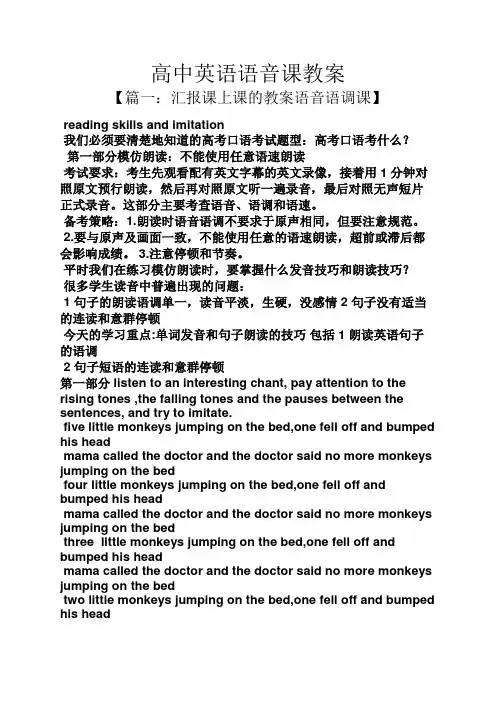
高中英语语音课教案【篇一:汇报课上课的教案语音语调课】reading skills and imitation我们必须要清楚地知道的高考口语考试题型:高考口语考什么?第一部分模仿朗读:不能使用任意语速朗读考试要求:考生先观看配有英文字幕的英文录像,接着用1分钟对照原文预行朗读,然后再对照原文听一遍录音,最后对照无声短片正式录音。
这部分主要考查语音、语调和语速。
备考策略:1.朗读时语音语调不要求于原声相同,但要注意规范。
2.要与原声及画面一致,不能使用任意的语速朗读,超前或滞后都会影响成绩。
3.注意停顿和节奏。
平时我们在练习模仿朗读时,要掌握什么发音技巧和朗读技巧?很多学生读音中普遍出现的问题:1 句子的朗读语调单一,读音平淡,生硬,没感情2 句子没有适当的连读和意群停顿今天的学习重点:单词发音和句子朗读的技巧包括 1 朗读英语句子的语调2 句子短语的连读和意群停顿第一部分 listen to an interesting chant, pay attention to the rising tones ,the falling tones and the pauses between the sentences, and try to imitate.five little monkeys jumping on the bed,one fell off and bumped his headmama called the doctor and the doctor said no more monkeys jumping on the bedfour little monkeys jumping on the bed,one fell off and bumped his headmama called the doctor and the doctor said no more monkeys jumping on the bedthree little monkeys jumping on the bed,one fell off and bumped his headmama called the doctor and the doctor said no more monkeys jumping on the bedtwo little monkeys jumping on the bed,one fell off and bumped his headmama called the doctor and the doctor said no more monkeys jumping on the bedone little monkeys jumping on the bed,one fell off and bumped his headmama called the doctor and the doctor said no more monkeys jumping on the bed英语口语训练形式、方法有很多种,但是要说好英语,第一步是要多听多读英语,并养成良好的朗读习惯。
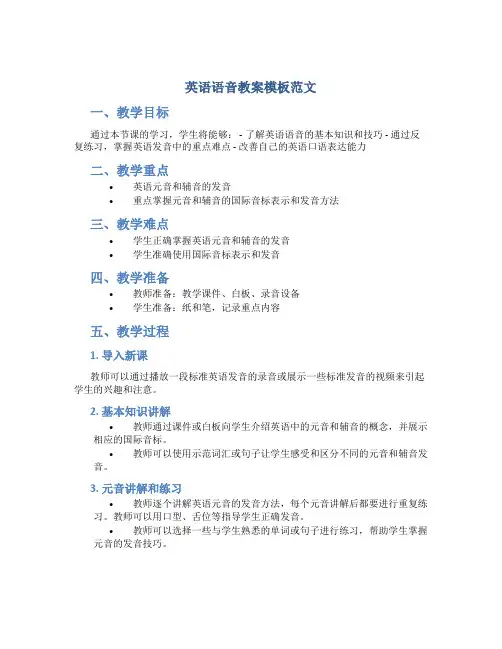
英语语音教案模板范文一、教学目标通过本节课的学习,学生将能够: - 了解英语语音的基本知识和技巧 - 通过反复练习,掌握英语发音中的重点难点 - 改善自己的英语口语表达能力二、教学重点•英语元音和辅音的发音•重点掌握元音和辅音的国际音标表示和发音方法三、教学难点•学生正确掌握英语元音和辅音的发音•学生准确使用国际音标表示和发音四、教学准备•教师准备:教学课件、白板、录音设备•学生准备:纸和笔,记录重点内容五、教学过程1. 导入新课教师可以通过播放一段标准英语发音的录音或展示一些标准发音的视频来引起学生的兴趣和注意。
2. 基本知识讲解•教师通过课件或白板向学生介绍英语中的元音和辅音的概念,并展示相应的国际音标。
•教师可以使用示范词汇或句子让学生感受和区分不同的元音和辅音发音。
3. 元音讲解和练习•教师逐个讲解英语元音的发音方法,每个元音讲解后都要进行重复练习。
教师可以用口型、舌位等指导学生正确发音。
•教师可以选择一些与学生熟悉的单词或句子进行练习,帮助学生掌握元音的发音技巧。
4. 辅音讲解和练习•教师逐个讲解英语辅音的发音方法,每个辅音讲解后都要进行重复练习。
教师可以用口型、舌位等指导学生正确发音。
•教师可以选择一些与学生熟悉的单词或句子进行练习,帮助学生掌握辅音的发音技巧。
5. 综合练习•教师可以设计一些口语练习活动,让学生运用所学的元音和辅音进行口语对话或朗读练习。
•教师可以播放一段录音让学生听写,以检验他们在课堂上所学的发音。
6. 总结和作业布置教师对本节课的要点进行总结,并布置相应的作业,包括巩固练习和自主练习。
学生需用纸和笔记录下作业内容。
六、板书设计英语语音教学- 教学目标- 教学重点- 教学难点- 教学准备- 教学过程- 导入新课- 基本知识讲解- 元音讲解和练习- 辅音讲解和练习- 综合练习- 总结和作业布置- 板书设计七、教学反思本节课以语音教学为主线,通过系统的讲解和大量的练习帮助学生掌握英语发音的基本知识和技巧。
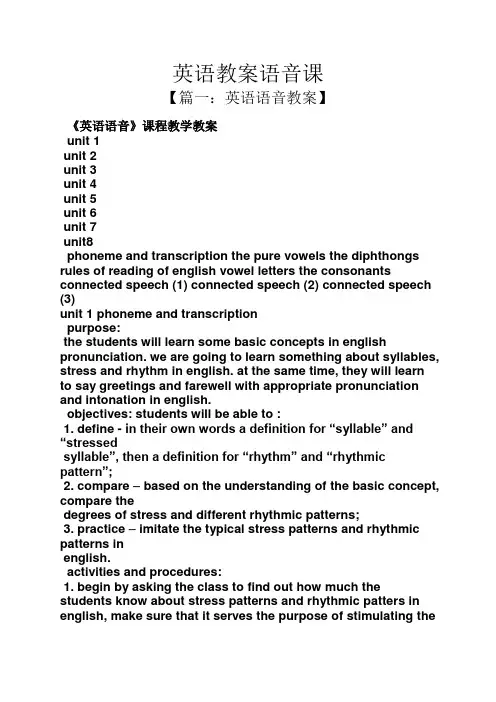
英语教案语音课【篇一:英语语音教案】《英语语音》课程教学教案unit 1unit 2unit 3unit 4unit 5unit 6unit 7unit8phoneme and transcription the pure vowels the diphthongs rules of reading of english vowel letters the consonants connected speech (1) connected speech (2) connected speech (3)unit 1 phoneme and transcriptionpurpose:the students will learn some basic concepts in english pronunciation. we are going to learn something about syllables, stress and rhythm in english. at the same time, they will learnto say greetings and farewell with appropriate pronunciation and intonation in english.objectives: students will be able to :1. define - in their own words a definition for “syllable” and “stressedsyllable”, then a definition for “rhythm” and “rhythmic pattern”;2. compare – based on the understanding of the basic concept, compare thedegrees of stress and different rhythmic patterns;3. practice – imitate the typical stress patterns and rhythmic patterns inenglish.activities and procedures:1. begin by asking the class to find out how much thestudents know about stress patterns and rhythmic patters in english, make sure that it serves the purpose of stimulating thestudents to think about the issue and have the desire to find out the answers themselves.2. display examples by playing the recording of the native speakers showing the typical stress patters and rhythmic patterns in english.3. ask the students to listen to the tapes to mark out the stressed syllables in words.4. ask the students to listen to the tapes to mark out the stressed words in sentences.5. have the students imitate the stress patterns and rhythmic patterns to experience the rhythm in speech.6. have the students share what they have learned by reading out the practice materials in pairs.7. have the students listen to the conversations recorded by native speakers of english and try to get the rhythmic patterns in their speech.8. have the students practice the guided conversation. ask them to pay special attention to the stress the rhythm in speech.9. highlight the language function in the conversation in the practice.10. have several pairs of the students present their conversation in the class.11. comment on the students? performance by highlighting the achievement of the students and the efforts they need for the improvement.12. ask the students to do more practice after class and get ready for presentation during the next session.basic concepts: syllables, stress rhythmin this unit, we are going to learn some basic concepts in english pronunciation. we are going to learn something about syllables, stress and rhythm in english. at thesame time, we are going to learn to say greetings and farewell with appropriate pronunciation and intonation in english.first of all, let?s look at the syllable in english.please listen to the following word: driveway.now, tell me, how many syllables there are in this word? right. there are two. please listen to the following sentence: drive him away.tell me, how many syllables there are in this sentence? right. there are four.introductionso. what is a syllable?a syllable is a word part and the basic unit of english rhythm. english words can have one, two, three or even more syllables. in the word ?driveway?, there are two syllables. in the sentence ?drive him away?, there are four.what is a stressed syllable?in english words with more than one syllable, one of them will receive more stress than the others. stressed syllables are those that are marked in the dictionary as stressed. for example, in the word ?driveway?, the first syllable is a stressed syllable while the second syllable is not.stressed syllables in english are usually longer, louder, and higher in pitch. listen to the following example:syllable 1 syllable 2 (short) (long)syllable 3(short)the word banana has 3 syllables. syllable 1 is not stressed and so is short. syllable 2 is stressed and so is long with a clear vowel sound / :/. syllable 3 is not stressed and so is also short. here is a short summary about the stressed and unstressed syllables:stressed syllables are strong syllables. unstressed syllables are weak syllables. stressed syllables:- are long- have a pitch change- have full vowel sounds.unstressed syllables:- are short- often have a reduced vowel sound.now let?s look at the rhythm in english.we all know that correct pronunciation of the individual english sounds is important in communication. the way the sounds are organized, however, is often more crucial for understanding. the rhythm of english, for example, is one of the two major organizing structures that native speakers rely on to process speech.what is rhythm?rhythm can be found everywhere in life: the sound of a clock, the beating of the heart, the strokes of a swimmer, and ofcourse in poetry and music. but rhythm in language is less familiar because it is less obvious. the rhythm of a language is characterized by the timing pattern of successive syllables. in some languages, every syllable is given about the same length, while in others, syllables vary in length. in english, strongbeats are called stress -- the heart of the rhythmic pattern.音节、重音与节奏本单元将向大家介绍英语语音语调的基本概念, 主要介绍英语语音的音节、重音和节奏规律。
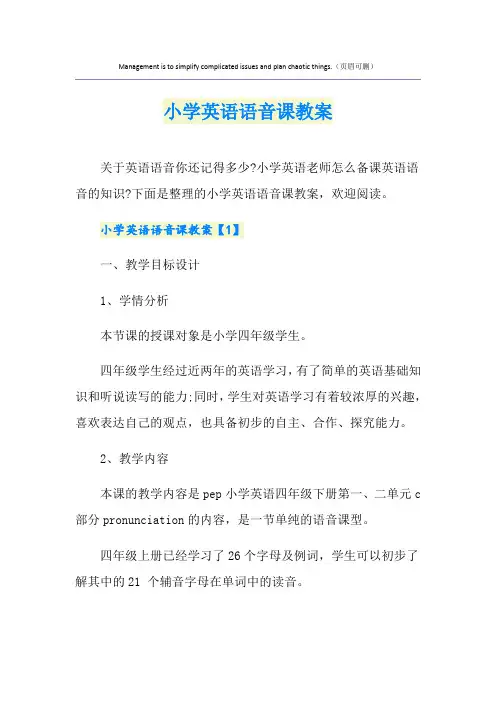
Management is to simplify complicated issues and plan chaotic things.(页眉可删)小学英语语音课教案关于英语语音你还记得多少?小学英语老师怎么备课英语语音的知识?下面是整理的小学英语语音课教案,欢迎阅读。
小学英语语音课教案【1】一、教学目标设计1、学情分析本节课的授课对象是小学四年级学生。
四年级学生经过近两年的英语学习,有了简单的英语基础知识和听说读写的能力;同时,学生对英语学习有着较浓厚的兴趣,喜欢表达自己的观点,也具备初步的自主、合作、探究能力。
2、教学内容本课的教学内容是pep小学英语四年级下册第一、二单元c 部分pronunciation的内容,是一节单纯的语音课型。
四年级上册已经学习了26个字母及例词,学生可以初步了解其中的21 个辅音字母在单词中的读音。
本节课的重点是启发学生通过仔细读单词,自己总结出元音字母aa和ee的发音规律,让学生获得成功感,进而提升自主学习的能力。
3、课标解读小学四年级应达到《义务教育英语课程标准》一级标准。
虽然在课程标准的一级标准里对语音没有明确要求,但有关小学语音教学的二级要求中对语音目标的要求是:(1)知道错误的发音会影响交际;(2)知道字母名称的读音;(3)了解简单的拼读规律;(4)了解单词有重音。
(5)语音清楚,语调自然。
4、教学目标知识目标:能够听懂,会说,会读音标“[ei] [] [i:] [e]和例词cake,snake,grapes, face,apple , bag , cat , hat, we,me , he , she,egg , bed , desk , pen”能力目标:(1)引导学生积极参加小组活动,促进他们养成动脑、动口和动手的好习惯,初步形成主动学习的意识。
(2)培养学生的分析能力。
情感目标:(1)进一步提高学生对英语的学习热情及学习兴趣。
(2)鼓励学生积极主动参与课堂活动,大胆开口,主动模仿。
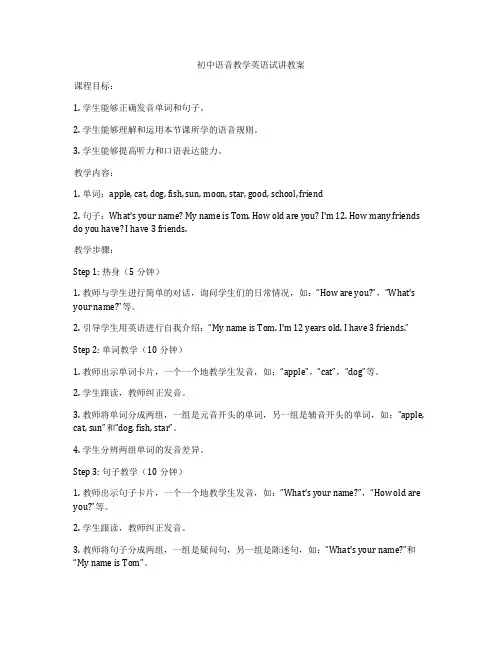
初中语音教学英语试讲教案课程目标:1. 学生能够正确发音单词和句子。
2. 学生能够理解和运用本节课所学的语音规则。
3. 学生能够提高听力和口语表达能力。
教学内容:1. 单词:apple, cat, dog, fish, sun, moon, star, good, school, friend2. 句子:What's your name? My name is Tom. How old are you? I'm 12. How many friends do you have? I have 3 friends.教学步骤:Step 1: 热身(5分钟)1. 教师与学生进行简单的对话,询问学生们的日常情况,如:“How are you?”,“What's your name?”等。
2. 引导学生用英语进行自我介绍:“My name is Tom. I'm 12 years old. I have 3 friends.”Step 2: 单词教学(10分钟)1. 教师出示单词卡片,一个一个地教学生发音,如:“apple”,“cat”,“dog”等。
2. 学生跟读,教师纠正发音。
3. 教师将单词分成两组,一组是元音开头的单词,另一组是辅音开头的单词,如:“apple, cat, sun”和“dog, fish, star”。
4. 学生分辨两组单词的发音差异。
Step 3: 句子教学(10分钟)1. 教师出示句子卡片,一个一个地教学生发音,如:“What's your name?”,“How old are you?”等。
2. 学生跟读,教师纠正发音。
3. 教师将句子分成两组,一组是疑问句,另一组是陈述句,如:“What's your name?”和“My name is Tom”。
4. 学生分辨两组句子的发音差异。
Step 4: 语音规则教学(10分钟)1. 教师讲解元音和辅音的发音规则。
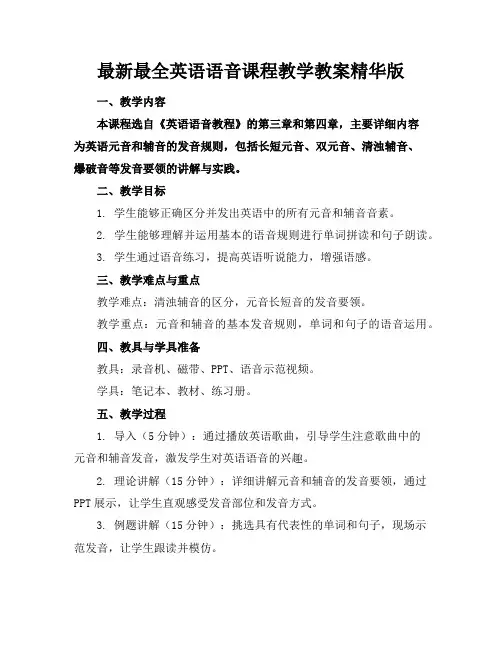
最新最全英语语音课程教学教案精华版一、教学内容本课程选自《英语语音教程》的第三章和第四章,主要详细内容为英语元音和辅音的发音规则,包括长短元音、双元音、清浊辅音、爆破音等发音要领的讲解与实践。
二、教学目标1. 学生能够正确区分并发出英语中的所有元音和辅音音素。
2. 学生能够理解并运用基本的语音规则进行单词拼读和句子朗读。
3. 学生通过语音练习,提高英语听说能力,增强语感。
三、教学难点与重点教学难点:清浊辅音的区分,元音长短音的发音要领。
教学重点:元音和辅音的基本发音规则,单词和句子的语音运用。
四、教具与学具准备教具:录音机、磁带、PPT、语音示范视频。
学具:笔记本、教材、练习册。
五、教学过程1. 导入(5分钟):通过播放英语歌曲,引导学生注意歌曲中的元音和辅音发音,激发学生对英语语音的兴趣。
2. 理论讲解(15分钟):详细讲解元音和辅音的发音要领,通过PPT展示,让学生直观感受发音部位和发音方式。
3. 例题讲解(15分钟):挑选具有代表性的单词和句子,现场示范发音,让学生跟读并模仿。
4. 随堂练习(10分钟):学生两人一组,进行元音和辅音的发音练习,相互纠正,教师巡回指导。
5. 小组活动(15分钟):分组进行单词拼读比赛,提高学生的语音运用能力。
六、板书设计1. 元音和辅音的分类及发音要领。
2. 典型单词和句子的发音示范。
3. 课堂练习及注意事项。
七、作业设计1. 作业题目:课后练习册第三章和第四章的练习题。
答案:参照教材和课堂讲解,自行完成作业。
2. 拓展作业:录制自己的英语发音视频,进行自我评价和同学互评。
八、课后反思及拓展延伸2. 拓展延伸:推荐学生参加英语语音培训课程,提高语音水平,增强英语实际运用能力。
同时,鼓励学生在日常生活中多听、多说、多模仿,提高英语语音素养。
重点和难点解析1. 清浊辅音的区分。
2. 元音长短音的发音要领。
3. 教学过程中的例题讲解和随堂练习。
4. 板书设计中的发音示范和注意事项。

英语语音教学的教案【篇一:七年级英语语音教学教案】七年级语音教学教案一、教学内容:教学生掌握12个单元音和并通过英语日常用语来让学生操练语音二、教学目标:(一)知识与技能1.学会12个单元音以及它们的音标的书写;2.理解音素、元音和辅音的概念;3.准确朗读12个单元音和含有单元音的字母和单词;4.能懂并且学会说4句英语日常用语。
(1)at first look at me and listen to me carefully, please.(2) follow me, please.(3) is that clear? (clear?)(4) the letter “e” is pronounced //.(二)过程与方法1.通过模仿—定型—自动化三个学习过程,使学生对要发音的要领有更深的体会,从而掌握单元音的准确读法;2.通过跟读、独自练读、接力读、唱读、双人读、小组竞赛等多种方式,培养学生良好的注意品质和合作学习意识。
3.初步掌握语音的学习方法。
(三)情感、态度和价值观1.通过语音学习让学生体验中英两种语言文化的差异性,让学生理解英语和汉语发音的区别,激发学生对英语学习的兴趣。
2.知道拼读是英语自学的最基本能力,而学会48个音素是获得拼读能力的基础,进一步激发英语学习的热情和兴趣。
三、教学重点:1.掌握单元音的发音要领,能够大声准确地朗读这些音素和含有单元音的字母以及单词;2.学会书写12个单元音;3.学会说一些简单英语常用口语来训练自己英语口语发音。
四、教学难点:2.准确的朗读音标五、教学步骤:step1: organization(5’) 1. 师生问好(规范要求)。
(1) ---good afternoon.-- good afternoon.(2)—how are you today?(3)---we’re very well. thank you. and you?----i’m fine, too.2.课堂组织(1)每个同学的位置可以用两个号码来定位,即number _和row_比如??例1,2,3??问学生有什么规律? s1:排叫做row,而列叫做number,后面的数字则表示第几排或者第几列。
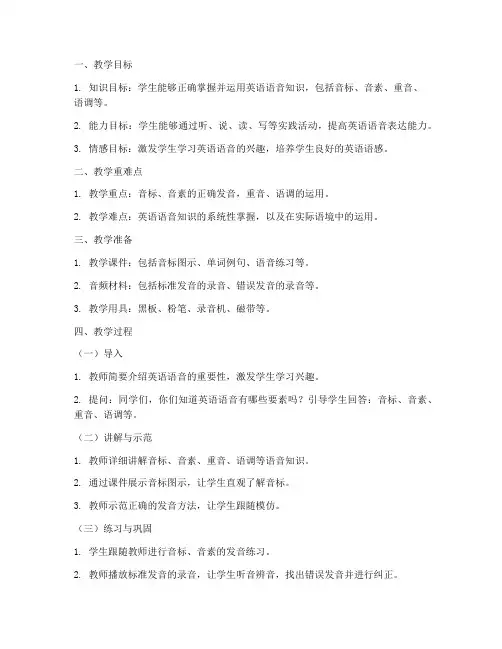
一、教学目标1. 知识目标:学生能够正确掌握并运用英语语音知识,包括音标、音素、重音、语调等。
2. 能力目标:学生能够通过听、说、读、写等实践活动,提高英语语音表达能力。
3. 情感目标:激发学生学习英语语音的兴趣,培养学生良好的英语语感。
二、教学重难点1. 教学重点:音标、音素的正确发音,重音、语调的运用。
2. 教学难点:英语语音知识的系统性掌握,以及在实际语境中的运用。
三、教学准备1. 教学课件:包括音标图示、单词例句、语音练习等。
2. 音频材料:包括标准发音的录音、错误发音的录音等。
3. 教学用具:黑板、粉笔、录音机、磁带等。
四、教学过程(一)导入1. 教师简要介绍英语语音的重要性,激发学生学习兴趣。
2. 提问:同学们,你们知道英语语音有哪些要素吗?引导学生回答:音标、音素、重音、语调等。
(二)讲解与示范1. 教师详细讲解音标、音素、重音、语调等语音知识。
2. 通过课件展示音标图示,让学生直观了解音标。
3. 教师示范正确的发音方法,让学生跟随模仿。
(三)练习与巩固1. 学生跟随教师进行音标、音素的发音练习。
2. 教师播放标准发音的录音,让学生听音辨音,找出错误发音并进行纠正。
3. 学生分组进行语音练习,互相纠正发音错误。
(四)拓展与应用1. 教师给出一些单词和句子,让学生运用所学语音知识进行朗读和翻译。
2. 学生进行角色扮演,模拟实际语境,运用语音知识进行交流。
(五)总结与反思1. 教师总结本节课所学的语音知识,强调重点和难点。
2. 学生分享自己在学习过程中的收获和体会,提出疑问和困惑。
五、课后作业1. 复习本节课所学的语音知识,巩固发音。
2. 播放英语语音教材,跟读并模仿发音。
3. 针对课后作业中的错误发音,查找原因并改正。
六、教学评价1. 课堂表现:观察学生在课堂上的参与程度、发音准确性等。
2. 课后作业:检查学生课后作业的完成情况,了解学生对语音知识的掌握程度。
3. 语音测试:定期进行语音测试,评估学生的学习成果。
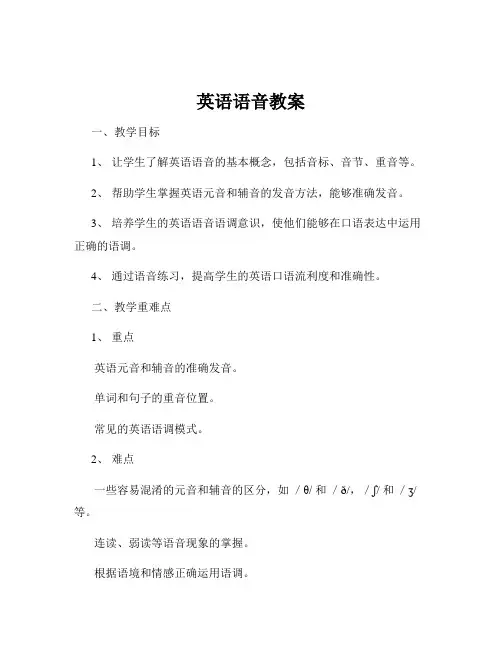
英语语音教案一、教学目标1、让学生了解英语语音的基本概念,包括音标、音节、重音等。
2、帮助学生掌握英语元音和辅音的发音方法,能够准确发音。
3、培养学生的英语语音语调意识,使他们能够在口语表达中运用正确的语调。
4、通过语音练习,提高学生的英语口语流利度和准确性。
二、教学重难点1、重点英语元音和辅音的准确发音。
单词和句子的重音位置。
常见的英语语调模式。
2、难点一些容易混淆的元音和辅音的区分,如/θ/ 和/ð/,/ʃ/ 和/ʒ/ 等。
连读、弱读等语音现象的掌握。
根据语境和情感正确运用语调。
三、教学方法1、讲授法讲解英语语音的基本概念和发音规则,让学生对语音知识有系统的了解。
2、示范法教师通过清晰、准确的发音示范,让学生模仿,直观地感受正确的发音方式。
3、练习法安排大量的发音练习,包括单个音素、单词、句子的练习,让学生在实践中巩固所学。
4、对比法对比容易混淆的音素,帮助学生找出差异,加深记忆。
5、多媒体辅助教学利用音频、视频等多媒体资源,丰富教学内容,增强学习的趣味性。
四、教学过程1、导入(5 分钟)通过播放一段英语原声电影片段或英语歌曲,引起学生对英语语音的兴趣,然后提问学生对英语语音的感受,引导学生思考语音在英语学习中的重要性。
2、知识讲解(20 分钟)介绍音标:展示音标表,讲解元音和辅音的分类和特点。
元音发音:逐个讲解元音的发音部位和方法,示范发音,让学生模仿练习。
辅音发音:同样的方式讲解辅音,重点强调容易出错的辅音。
音节和重音:解释音节的构成和重音的规则,通过单词示例让学生体会。
3、练习巩固(20 分钟)音素练习:教师发音,学生跟读,然后学生单独发音,教师纠正。
单词练习:给出一些包含所学音素的单词,让学生练习发音。
句子练习:朗读句子,注意单词的重音和句子的语调。
4、小组活动(15 分钟)将学生分成小组,进行对话练习,要求运用所学的语音知识,注意发音的准确性和语调的自然。
小组之间互相倾听、评价和纠正。

英语语音课教学设计【语音课教案】Teaching Plan for English Pronunciation Practice 《英语语音》课程教学教案Unit 1 Basic Concepts: Syllables, Stress & Rhythm Unit 2 Consonants: Stops Unit 3 Consonants: Fricatives and Affricates Unit 4 Consonants: Nasals, Approximants & Literal(s) Unit 5 V owels: Front Vowels & Central V owels Unit 6 V owels: Back V owels Unit 7 V owels: Diphthongs Unit8 Stressed Syllables & Unstressed Syllables Unit 9 Stressed Words & Unstressed Words in a Sentence Unit 10 Strong Forms and Weak Forms Unit 11 Linking Unit 12 Rhythm of English Speech Unit 13 Types of Intonation in English Unit 14 Intonation Units of English Unit 15 Functions & Uses of English Intonation 概论English Phonemes Study 英语音素学习 1. Some concepts about phonology: 几个语音学的概念 1)letters: words spelling symbols. 字母:词语的拼写符号。
2) phonetic elements (phoneme1): voice elements in speaking. 音素:语音的要素。
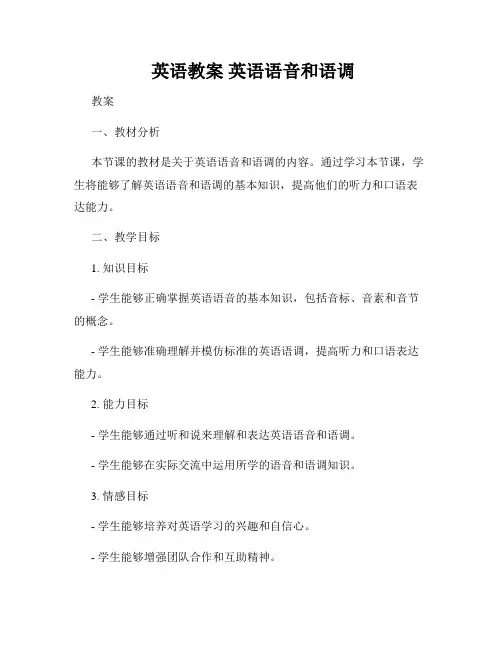
英语教案英语语音和语调教案一、教材分析本节课的教材是关于英语语音和语调的内容。
通过学习本节课,学生将能够了解英语语音和语调的基本知识,提高他们的听力和口语表达能力。
二、教学目标1. 知识目标- 学生能够正确掌握英语语音的基本知识,包括音标、音素和音节的概念。
- 学生能够准确理解并模仿标准的英语语调,提高听力和口语表达能力。
2. 能力目标- 学生能够通过听和说来理解和表达英语语音和语调。
- 学生能够在实际交流中运用所学的语音和语调知识。
3. 情感目标- 学生能够培养对英语学习的兴趣和自信心。
- 学生能够增强团队合作和互助精神。
三、教学重点- 学生能够准确掌握英语语音的基本知识和语调的特点。
- 学生能够正确理解和模仿英语语音和语调。
四、教学难点- 学生能够在实际交流中运用所学的语音和语调知识。
五、教学过程1. 导入(5分钟)- 利用一段有趣的英语短视频引入本节课。
- 引导学生思考:为什么英语语音和语调很重要?2. 学习语音知识(15分钟)- 通过音标表介绍英语语音的基本知识。
- 引导学生准确拼读并模仿音标。
3. 学习语调知识(15分钟)- 通过示范和练习,让学生感受标准英语语调的特点。
- 引导学生模仿并朗读具有不同语调的句子。
4. 听力训练(20分钟)- 播放一段录音,让学生听并回答相关问题。
- 引导学生注意录音中的语音和语调特点。
5. 口语练习(20分钟)- 分组进行角色扮演,模拟实际对话情景。
- 指导学生使用正确的语音和语调进行对话。
6. 小结(5分钟)- 对本节课所学的语音和语调知识进行总结。
- 引导学生回答相关问题,检查他们的学习效果。
七、作业布置(5分钟)- 要求学生通过录音或书面形式,描述一个与语音和语调相关的情景,并使用所学的知识进行表达。
八、板书设计- 单词:音标、音素、音节- 语调:上升调、下降调、平调九、教学反思本节课通过多种形式的教学活动,有效地激发了学生的学习兴趣。
学生在课堂上积极参与,通过听、说、读、写的综合训练,不仅提高了他们的语音和语调准确性,还增强了他们的口语表达和听力理解能力。
英语语音课教案模板一、教学目标本节课的教学目标是使学生能够正确发音并准确使用以下英语音标:/s/,/z/,/θ/,/ð/。
二、教学内容1.学习音标/s/和/z/的发音;2.学习音标/θ/和/ð/的发音;3.练习使用不同音标进行单词的发音;4.进行听力练习,判断音标发音的区别。
三、教学步骤1. 导入新知教师简要介绍本节课的教学内容和目标,并与学生一起回顾前一节课所学的音标/s/和/z/的发音方法。
2. 学习音标/θ/和/ð/的发音教师通过示范和口型指导,向学生介绍音标/θ/和/ð/的发音方法。
重点指出两者的区别,帮助学生正确发音。
3. 练习使用音标教师出示单词卡片,要求学生根据音标的不同发音,将单词正确分类。
学生根据发音进行分组讨论,然后向全班汇报自己的分类结果。
4. 听力练习教师播放一段包含音标/s/,/z/,/θ/,/ð/的录音,并在录音中加入一些例句。
学生需要仔细倾听并记录听到的单词,然后用音标标注出来。
随后,教师播放录音的解答部分,学生互相交流比较答案以及发音的准确性。
5. 练习巩固教师设计一系列练习题,包括单词拼写、听力判断和口语练习等,以帮助学生巩固所学的音标。
6. 小结与作业布置教师对本节课的学习内容进行小结,并布置相关的作业。
作业包括完成课后练习册上的相关练习,以及收集并整理更多包含音标/θ/和/ð/的单词和例句。
四、教学资源1.相关单词卡片;2.录音机或电脑播放设备;3.课后练习册。
五、教学评估教师将通过学生在课堂练习和作业中的表现来评估他们对本节课所学内容的掌握情况。
同时,教师还将通过观察学生在练习中的发音准确性和听力理解能力来评估他们的学习进展。
六、教学延伸为了进一步巩固和提高学生对音标的掌握,教师可以引导学生进行更多的口语练习,并提供更多的听力材料和相关学习资源供学生自主学习和拓展。
七、教学反思通过本节课的教学实践,发现学生对音标/θ/和/ð/的发音有一定的困惑,建议在接下来的教学中加强针对这两个音标的练习和强调。
小学英语语音教学教案
教案:
目标:通过语音教学,帮助学生正确发音并掌握一些基本的音标。
时长:40分钟。
教学步骤:
1. 情景导入(5分钟)
- 老师向学生介绍今天的学习内容是关于英语语音的。
- 老师播放一段短视频或歌曲,让学生听一听英语的发音。
2. 耳朵训练(10分钟)
- 老师播放一些简短的录音,让学生辨认录音中的单词或句子。
- 老师提示学生注意每个单词的发音特点。
3. 发音练习(15分钟)
- 老师向学生介绍一些常见的音标,如/æ/、/i:/、/ə/、/θ/ 等,并解释每个音标的发音规则。
- 老师向学生展示如何正确发音,并让学生跟着练习。
- 老师可以利用练习材料或图片进行发音示范和练习。
4. 操练和巩固(10分钟)
- 老师让学生两两合作,进行发音对练。
- 老师选几个学生到前面进行发音演示,大家一起评价是否
发音正确。
5. 总结和反馈(5分钟)
- 老师总结今天的学习内容,强调学生应该注意发音的重要性,并提醒学生在学习英语时要多加练习。
扩展活动:
- 老师可以让学生在家自己录制一段英文朗读,并需要检查自己是否发音正确。
- 老师可以邀请一位外教来校给学生进行发音指导。
教案标题:英语语音学教案课时安排:2课时(90分钟)教学目标:1. 让学生了解和掌握英语语音的基本概念和术语,如音素、音标、音节、重音、语调等。
2. 培养学生正确发音英语字母和字母组合的能力。
3. 提高学生对英语语音的感知和辨析能力。
4. 引导学生运用所学的语音知识进行实际的语言实践。
教学内容:1. 英语语音基本概念和术语的介绍。
2. 英语字母和字母组合的发音规则。
3. 音标的使用和练习。
4. 语音实践活动。
教学步骤:第一课时:一、导入(10分钟)1. 向学生简单介绍英语语音的重要性。
2. 引导学生回顾已学习的英语字母和字母组合。
二、新课内容(20分钟)1. 介绍音素、音标、音节、重音、语调等基本概念。
2. 讲解英语字母和字母组合的发音规则。
3. 演示和练习发音技巧。
三、练习(20分钟)1. 学生分组,互相练习发音。
2. 教师选取一些学生进行发音展示,并给予反馈。
四、总结(5分钟)1. 让学生复述所学内容。
2. 强调语音学习的重要性。
第二课时:一、复习(10分钟)1. 复习上节课所学的语音基本概念和术语。
2. 复习英语字母和字母组合的发音规则。
二、音标的使用(20分钟)1. 讲解音标的书写和发音方法。
2. 学生练习音标的书写和发音。
三、语音实践(20分钟)1. 学生分组,进行语音练习。
2. 教师选取一些学生进行发音展示,并给予反馈。
四、总结(5分钟)1. 让学生复述所学内容。
2. 强调语音学习的重要性,并鼓励学生在日常学习中多练习发音。
教学评价:1. 课后收集学生的发音练习录音,对发音准确性进行评价。
2. 在下一节课开始时,让学生进行语音知识的小测验,了解学生对知识的掌握程度。
教学资源:1. 英语语音教学PPT。
2. 音标卡片。
3. 录音设备。
教学建议:1. 教师应具备良好的发音,为学生提供正确的示范。
2. 鼓励学生在课后多听、多说,提高语音感知和辨析能力。
3. 定期进行语音练习和测试,检查学生对知识的掌握程度。
小学英语语音课教案一、教学内容本节课为人教版小学英语PEP教材第三册第五单元A部分,主要内容为学习字母组合“oo”的发音。
通过学习,学生能够正确发音字母组合“oo”,并能够运用到单词中。
二、教学目标1. 学生能够正确发音字母组合“oo”。
2. 学生能够理解和运用所学单词。
3. 学生能够通过听、说、读、写的实践,提高英语语言能力。
三、教学难点与重点重点:字母组合“oo”的发音及运用。
难点:字母组合“oo”在不同单词中的发音。
四、教具与学具准备教具:多媒体课件、单词卡片、录音机、磁带。
学具:课本、练习本、铅笔、橡皮。
五、教学过程1. 热身(5分钟)教师与学生用英语进行简单的问候,然后带领学生复习已学过的字母和字母组合。
2. 引入(10分钟)教师展示与字母组合“oo”相关的单词,如:book, look, cook 等,引导学生关注字母组合“oo”的发音。
3. 讲解(15分钟)教师讲解字母组合“oo”的发音规则,并通过示例单词进行讲解。
同时,教师引导学生跟读,确保学生正确发音。
4. 实践(10分钟)教师组织学生进行小组活动,让学生相互练习字母组合“oo”的发音。
然后,教师选取几组学生进行展示,并对发音正确的同学给予表扬。
5. 巩固(5分钟)教师发放单词卡片,让学生分组进行单词接龙游戏,要求使用字母组合“oo”的单词。
六、板书设计板书内容:字母组合“oo”的发音规则及示例单词。
七、作业设计1. 作业题目:(1)请用字母组合“oo”的正确发音读下列单词:book, look, cook, too, good。
(2)请用所给单词造句,并使用字母组合“oo”的正确发音。
2. 答案:(1)book [bʊk], look [lʊk], cook [kʊk], too [tuː], good [gʊd]。
(2)示例:I have a book. She is too good.八、课后反思及拓展延伸教师在课后对本次课程进行反思,观察学生对字母组合“oo”发音的掌握情况,并在下一节课中进行针对性的复习。
第一周新生未入学第二周本课程介绍课程的目的:《英语语音》( )为中职学校商务英语专业一年级学生开设,本课程系英语专业之必修课,旨在指导学生在理论的指导下进行英语语音语调的练习与实践,从而掌握英语的发音和语调的功能,学会使用恰当的英语语音语调进行朗读与表述。
与此同时,课程将通过对学生进行英语语音语调的正误分析训练,集中性、突破性解决我国学生在英语发音普遍存在的问题与困扰,从而提高学生英语发音的纯正与流利程度,为学生的英语听说能力的发展打下坚实的基础,达到实现准确流畅地使用英语进行交际之目的。
教学对象:本课程的教学对象为商务英语专业和国际商务专业学生。
教学目的:学生通过本课程的学习,掌握正确标准的英语发音、节奏规律和语调,学会使用自然得体的英语语音语调表达思想,以达到交际的目的。
同时,本课程将语音的训练与学生英语听能和口语表达的训练结合起来,以达到能流利地对所听到的英语语篇进行解码,能流畅地使用进行交际。
教学内容组织方式与目的课程各个单元的编排由以下几个部分组成:1.英语语音知识的简单介绍;2.听辨、听力训练;3.发音、口语训练;4、重音模式和语调模仿训练;5、检测实际使用能力的训练,即以完成某项任务为手段的交际练习。
为了强化重音与节奏的训练,每个单元的听力与口语练习除了该单元所学习的重点语音项目外,还包含旨在帮助学生更好掌握英语重音、重音模式和节奏模式的练习,目的在于帮助学生深刻认识英语话语中重音与节奏的模式与规律,提高学生语音识别的流畅度,帮助学生学会自觉地模仿正确的重音和节奏,提高话语的流利程度,养成良好的口语表达习惯,以达到实现有效交际的目的。
课程教学内容强调理论联系实际,强调学生的能力培养。
第三周[i] [i:] [e] [æ]教学目标:音素的发音教学重点:音素的发音与发音的字母组合教学难点:学生对录音的模仿教学步骤:一,教师逐个讲解因素的发音要点,并且领读二,听录音,学生跟读三,教师领读单词和词组,句子四,学生齐读,分组读,单个学生朗读五,附以下学习资料[i] 短元音。
《英语语音》课程教学教案Unit 1 Phoneme and TranscriptionUnit 2 The Pure VowelsUnit 3 The DiphthongsUnit 4 Rules of Reading of English Vowel Letters Unit 5 The ConsonantsUnit 6 Connected Speech (1)Unit 7 Connected Speech (2)Unit8 Connected Speech (3)Unit 1 Phoneme and TranscriptionPurpose:The students will learn some basic concepts in English pronunciation. We are going to learn something about syllables, stress and rhythm in English. At the same time, they will learn to say greetings and farewell with appropriate pronunciation and intonation in English.Objectives: Students will be able to :1.Define - in their own words a definition for “syllable”and “stressedsyllable”, then a definition for “rhythm” and “rhythmic pattern”;pare – based on the understanding of the basic concept, compare thedegrees of stress and different rhythmic patterns;3.Practice –imitate the typical stress patterns and rhythmic patterns inEnglish.Activities and Procedures:1.Begin by asking the class to find out how much the students know about stresspatterns and rhythmic patters in English, make sure that it serves the purpose of stimulating the students to think about the issue and have the desire to find out the answers themselves.2.Display examples by playing the recording of the native speakers showing thetypical stress patters and rhythmic patterns in English.3.Ask the students to listen to the tapes to mark out the stressed syllables in words.4.Ask the students to listen to the tapes to mark out the stressed words in sentences.5.Have the students imitate the stress patterns and rhythmic patterns to experiencethe rhythm in speech.6.Have the students share what they have learned by reading out the practicematerials in pairs.7.Have the students listen to the conversations recorded by native speakers ofEnglish and try to get the rhythmic patterns in their speech.8.Have the students practice the guided conversation. Ask them to pay specialattention to the stress the rhythm in speech.9.Highlight the language function in the conversation in the practice.10.Have several pairs of the students present their conversation in the class.ment on the students’performance by highlighting the achievement of thestudents and the efforts they need for the improvement.12.Ask the students to do more practice after class and get ready for presentation during the nextsession.Basic Concepts: Syllables, Stress & RhythmIn this unit, we are going to learn some basic concepts in English pronunciation. We are going to learn something about syllables, stress and rhythm in English. At thesame time, we are going to learn to say greetings and farewell with appropriate pronunciation and intonation in English.First of all, let’s look at the syllable in English.Please listen to the following word: driveway.Now, tell me, how many syllables there are in this word? Right. There are two. Please listen to the following sentence: Drive him away.Tell me, how many syllables there are in this sentence? Right. There are four. IntroductionSo. What is a syllable?A syllable is a word part and the basic unit of English rhythm. English words can have one, two, three or even more syllables. In the word ‘driveway’, there are two syllables. In the sentence ‘Drive him away’, there are four.What is a stressed syllable?In English words with more than one syllable, one of them will receive more stress than the others. Stressed syllables are those that are marked in the dictionary as stressed. For example, in the word ‘driveway’, the first syllable i s a stressed syllable while the second syllable is not.Stressed syllables in English are usually longer, louder, and higher in pitch.Listen to the following example:ba NAAAA naSyllable 1 Syllable 2 Syllable 3(short) (long) (short)The word "banana" has 3 syllables. Syllable 1 is not stressed and so is short. Syllable 2 is stressed and so is long with a clear vowel sound / :/. Syllable 3 is not stressed and so is also short.Here is a short summary about the stressed and unstressed syllables:Stressed syllables are strong syllables. Unstressed syllables are weak syllables.Stressed syllables:-are long-have a pitch change-have full vowel sounds.Unstressed syllables:-are short-often have a reduced vowel sound.Now let’s look at the rhythm in English.We all know that correct pronunciation of the individual English sounds is important in communication. The way the sounds are organized, however, is often more crucial for understanding. The rhythm of English, for example, is one of the two major organizing structures that native speakers rely on to process speech.What is rhythm?Rhythm can be found everywhere in life: the sound of a clock, the beating of the heart, the strokes of a swimmer, and of course in poetry and music. But rhythm in language is less familiar because it is less obvious. The rhythm of a language is characterized by the timing pattern of successive syllables. In some languages, every syllable is given about the same length, while in others, syllables vary in length. In English, strong beats are called stress -- the heart of the rhythmic pattern.音节、重音与节奏本单元将向大家介绍英语语音语调的基本概念, 主要介绍英语语音的音节、重音和节奏规律。
语音英语教案小学英语语音课教学案例国培小学英语四班王凤琴一、教学目标设计1、学情分析本节课的授课对象是小学四年级学生。
四年级学生经过近两年的英语学习,有了简单的英语基础知识和听说读写的能力;同时,学生对英语学习有着较浓厚的兴趣,喜欢表达自己的观点,也具备初步的自主、合作、探究能力。
2、教学内容本课的教学内容是pep小学英语四年级下册第一、二单元c部分pronunciation的内容,是一节单纯的语音课型。
四年级上册已经学习了26个字母及例词,学生可以初步了解其中的21 个辅音字母在单词中的读音。
本节课的重点是启发学生通过仔细读单词,自己总结出元音字母aa和ee的发音规律,让学生获得成功感,进而提升自主学习的能力。
3、课标解读小学四年级应达到《义务教育英语课程标准》一级标准。
虽然在课程标准的一级标准里对语音没有明确要求,但有关小学语音教学的二级要求中对语音目标的要求是:(1)知道错误的发音会影响交际;(2)知道字母名称的读音;(3)了解简单的拼读规律;(4)了解单词有重音。
(5)语音清楚,语调自然。
4、教学目标知识目标:能够听懂,会说,会读音标“ [ei] [?] [i:] [e]和例词cake, snake,grapes, face,apple , bag , cat , hat, we,me , he ,she,egg , bed , desk ,pen”能力目标:(1)引导学生积极参加小组活动,促进他们养成动脑、动口和动手的好习惯,初步形成主动学习的意识。
(2)培养学生的分析能力。
情感目标:(1)进一步提高学生对英语的学习热情及学习兴趣。
(2)鼓励学生积极主动参与课堂活动,大胆开口,主动模仿。
教学重点、难点:能够听懂,会说,会读音标“ [ei] [?] [i:] [e]和例词cake, snake,grapes, face,apple , bag , cat , hat, we,me , he ,she,egg , bed , desk ,pen”教具准备:课件、单词卡片和磁铁。
二、教学模式设计授课的主要内容为《pep小学英语》四年级下册第一、二单元c部分pronunciation的内容,是一节单纯的语音课型。
本节课的重点是启发学生通过仔细读单词,自己总结出元音字母aa和ee的发音规律,会读课本中的16个例词和四个音标[ei] ,[?] ,[i:]和 [e]。
让学生获得成功感,进而提升自主学习的能力。
教案设计如下:(一)改进设计总结第一次失败的教训,笔者有了以下的收获:(1)明确于本节课的重点是启发学生通过仔细读单词,自己总结出元音字母aa和ee的发音规律,会读课本中的16个例词和四个音标[ei] ,[?] ,[i:]和 [e]。
让学生获得成功感,进而提升自主学习的能力。
(2)音标教学能否达到预期目的和理想效果,要使学生学得好,最关键的问题是如何引导,如何去教。
我的教学设计是:step1、warming up1、师生问候。
设计意图:拉进师生之间的距离。
2、共唱歌曲“ abc ” song.之后,询问:在abc歌曲里有多少个字母?多少个元音字母?从而导入新课。
今天我们来学习元音字母aa和ee的发音。
教学方法是用歌曲教学法。
设计意图:轻松的歌曲可以减缓学生课前的紧张情绪,营造和谐的英语学习氛围。
同时为新课教学做铺垫。
step2 、presentation1、教师出示课件,播放课件,学生听后回答:“上面单词中a的发音相同吗?”教学方法是直观教学法。
设计意图:通过让学生感知、体验,自己总结出元音字母aa在单词中的发音规律。
2、播放课件,学生跟读之后回答:what does “aa” sounds likein these words?引导学生回答:aa sounds like [ei] in cake ,grape,face,snake。
教学方法是直观教学法。
设计意图:通过让学生感知、体验,自己总结出元音字母aa在单词中的发音规律。
3、老师教读音标[ei]及例词。
(编歌谣:爷爷砍树,[ei] [ei] [ei])教学方法tpr和编唱歌谣教学法。
设计意图:在教授音标的时候,采用tpr和编唱歌谣教学法。
有利于激发学生的兴趣,帮助学生记忆。
4、播放课件,学生跟读之后回答:what does “aa” sounds likein these words?引导学生回答:aa sounds like [?] in apple ,bag ,cat ,hat .教学方法是直观教学法。
设计意图:通过让学生感知、体验,自己总结出元音字母aa在单词中的发音规律。
5、老师教读音标[?]及例词。
(编歌谣:大嘴巴,大嘴巴,[?] [?] [?])教学方法tpr和编唱歌谣教学法。
设计意图:在教授音标的时候,采用tpr和编唱歌谣教学法。
有利于激发学生的兴趣,帮助学生记忆。
6、以同样的方式教学字母ee的发音。
ee sounds like [i:] in we,me ,she ,he 。
ee sounds like [e] in bed ,pen, desk egg。
(编歌谣:穿针引线,[i:] [i:] [i:];小嘴巴,小嘴巴,[e] [e] [e] )教学方法是直观教学法,tpr和编唱歌谣教学法。
设计意图:通过让学生感知、体验,自己总结出元音字母ee在单词中的发音规律。
有利于激发学生的兴趣,帮助学生记忆。
7、全班齐读课本11页和23页pronunciation中的单词。
教学方法是朗读教学法。
设计意图:让学生对本节课所学内容有个整体回顾。
step3 、prctice1、看动作猜音标2、看口形猜音标。
3、听音标举卡片。
教师准备若干音标卡片,然后教师说:show me your[ei],show me your[?] ,show me your [i:],show me your [e]。
4、听单词举音标卡片。
老师准备单词卡片若干。
如:老师举单词卡cake,让学生找字母a在单词cake 的发音,举起相应的音标卡片。
step4、production1、游戏“找家人”。
教师把全班分成四个小组。
准备单词卡片若干和四张画有房子的纸。
每张房屋上分别写上四个音标。
要求学生帮四个音标找到他们的家人并贴在画有房间的纸上。
最先完成没有错误的组为优胜组。
给每个人奖励一个小贴片。
教学方法有tpr和游戏教学法。
设计意图:通过学生亲自参与体验、游戏和合作的方式激发学生学习的兴趣,考察学生的分析与记忆能力。
形成积极地学习态度。
2、说一说[ei][ei][ei] say “ok”.[?] [?] [?] look at the blackboard.[i:] [i:] [i:] drink some tea.[e] [e] [e] let it rest.教学方法是学说顺口溜教学法。
设计意图:学说顺口溜不仅可以使知识变得简单、生动、印象深刻,而且通过这样的训练,真正将语音教学落到实处。
step5、summarywhat did you learn in this class? we learned aa and ee’s pronunciation.教学方法是启发式教学法。
设计意图:通过对知识的小结,帮助学生将本课的信息进行加工、储存,从而明确教学目标、重点和难点。
step6、homework做活动手册上的习题。
(二)教学反思本次试教过程循序渐进,从热身活动到巩固练习环节,每个教学环节都是根据学生的知识水平、接受能力而设计。
各教学环节衔接自然、层次清晰,教学目标明确,教学重点突出。
课堂上主意调动学生的积极性,教学过程体现了学生的主体性,学生的学习积极性较高。
注意将语言知识的学习与实际运用相结合,在发展学生运用能力的同时,特别注意培养学生观察、思考、分析和总结的能力。
采用多媒体课件,单词卡片形象直观的教学手段,结合歌曲、编顺口溜、tpr和游戏等教学法。
通过感知、体验、实践、参与和合作等方式,充分发挥了教师的主导和学生的主体作用。
引导学生在合作学习中体验、探究、发现问题、寻找解决问题的方法。
学生能顺利的发现总结出元音字母aa和ee在单词里的基本发音规则,准确读出例词。
符合小学生的生理和心理特点,激发了他们学习英语的兴趣,教学效果良好。
【篇二:初中英语语音教学案例】初中英语语音教学案例(第一课时):房县白窝中学王厚平一、教学任务:①音标知识的简单介绍;②音标知识的重要性;③教学音标: a,辅音:能正确识读 28个辅音;b,元音:元音字母在开、闭音节中的发音。
二、教学重点:①开、闭音节的区分及元音字母在开、闭音节中的发音② 28个辅音的认读,尤其是6个爆破音的认读。
三、教学难点:开、闭音节的区分及元音字母在开、闭音节中的梵音和28个辅音的认读四、教学步骤:step one everyday english(日常用语)⒈----good morning,hellen!(afternoon/evening)---- good morning,alice!(afternoon/evening)⒉---how do you do!----how do you do!⒊----how are you ?----fine, thank you,and you?/ i’m ok.thanks.----i’m fine, too.⒋----what’s your name?---- my name is mary/tom. (i am mary)⒌--- can you spell it,please?---- yes, m—a—r—y,mary.⒍---- are you clear?---- yes.?no.⒎read after me,please.⒏look at the blackboard. please.⒐exchange, please.(注;第6、7、8、9的项目只要求学生明白指令并作出反应即可) step two①简单介绍音标的知识,(联系汉语拼音)②说明学习音标的重要性。
(让学生明白学好音标除了能自己独立识读英语单词外,更重要的是能轻松记忆后面将要学到的所有单词,而记忆好单词是学好英语的最基本保证。
)③音标慨况:元音(单双元音);辅音(清浊辅音)。
step three①开音节与闭音节的认识及开闭音节单词的区别练习;②元音字母在开、闭音节中的发音及练习③让学生反复练习元音字母在开闭音节中的发音。
step four①元音和辅音的初步认识;②辅音的教学及6个爆破音的正确认读五、课堂作业及训练、测试①单项选择( ) 1.英语共有____元音字母;国际音标共有___个,其中辅音____个,爆破音____个。
a.5,48,20,10b.21,48,28, 6 c .26,48,5,10 d.5,48,28,6() 2.下列单词中为开音节的是______。